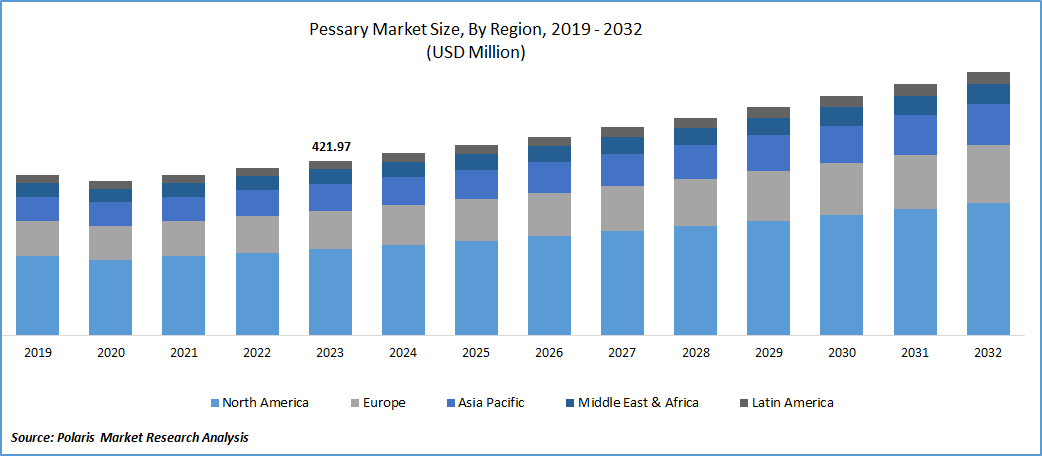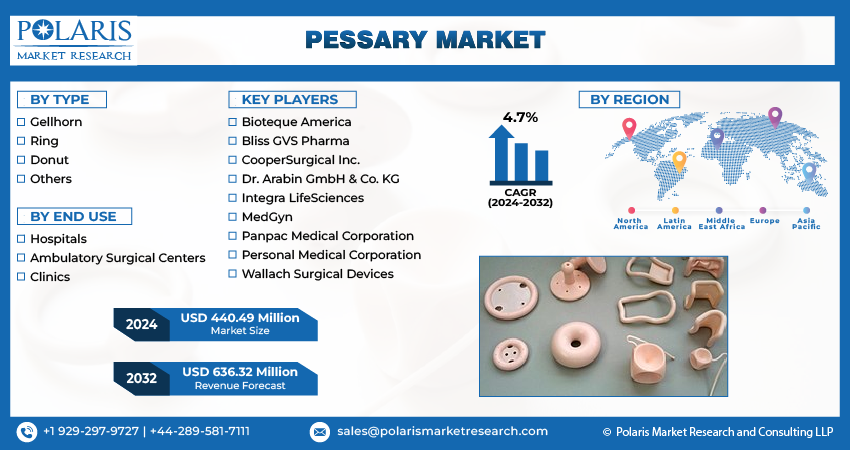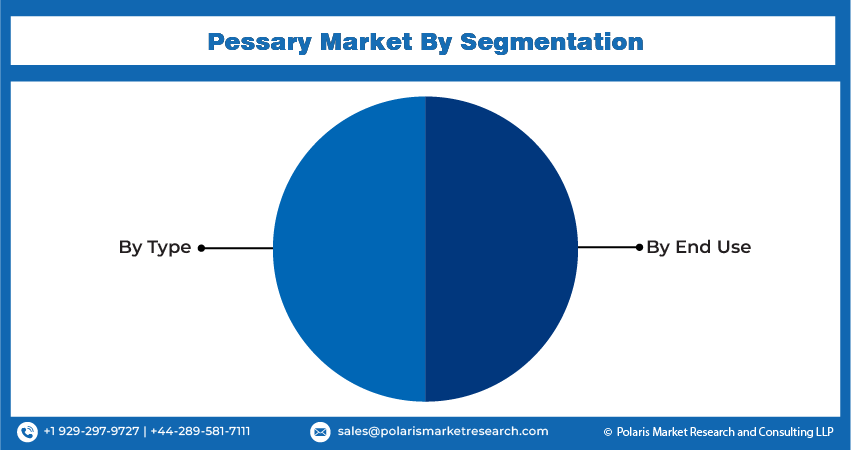
Pessary Market Share, Size, Trends, Industry Analysis Report, By Type (Gellhorn, Ring, Donut), By End-use (Hospitals, Ambulatory Surgical Centers, Clinics), By Region, And Segment Forecasts, 2024 - 2032
- Published Date:Jan-2024
- Pages: 117
- Format: PDF
- Report ID: PM4205
- Base Year: 2023
- Historical Data: 2019-2022
Report Outlook
The global pessary market was valued at USD 421.97 million in 2023 and is expected to grow at a CAGR of 4.7% during the forecast period.
One significant contributor is the rising prevalence of pelvic organ prolapse; a condition more commonly observed in the aging population. The elderly demographic is particularly susceptible to this condition, and the availability of products addressing pelvic support has become more widespread. Additionally, factors such as evolving lifestyles and the rapid development of noninvasive treatment options contribute to the growth of this market.

To Understand More About this Research: Request a Free Sample Report
Stress urine incontinence, a condition associated with weakened pelvic muscles, is also a driving factor. Patients with poor nutritional status are more likely to experience this type of incontinence, emphasizing the demand for advanced pelvic support devices that can provide effective solutions. As a result, the market is expected to witness significant growth in the coming years.
The demand for pessaries has increased due to the rising prevalence of pelvic organ prolapse and urine incontinence. According to a November 2021 article in the International Urogynecology Journal, approximately 40% of women experience pelvic organ prolapse (POP). Pessary treatment has shown high levels of patient satisfaction (75.3%), efficacy (90.7%), and a positive impact on improving vaginal and sexual symptoms, quality of life, and mental health. The article suggests that the membrane-free variety of ring pessary, which allows for sexual activity while retaining less vaginal discharge, is the most used and superior to occlusive (Gellhorn) types or devices.
The continuous launch of new products, expansions into different geographical regions, a strong emphasis on research and development by both market players and academic institutions, along with government initiatives, are key factors expected to drive market growth. In February 2021, Cosm Medical obtained Health Canada Investigational Testing Authorization (ITA) approval for a clinical study of its Gynethotics customized gynecological prosthetics. Cosm utilizes a pelvic floor measurement system, incorporating innovative ultrasound technology, to design pessaries tailored to individual patients' anatomy and lifestyle requirements.

Industry Dynamics
Growth Drivers
Increasing Prevalence of Pelvic Floor Disorders
Vaginal pessaries emerge as a preferred choice for treating organ prolapse and incontinence due to their perceived simplicity, affordability, and safety. These attributes contribute to a higher level of patient satisfaction when compared to alternative treatment options. Consequently, vaginal pessaries are often prioritized as the primary treatment for conditions like pelvic prolapse and stress urinary incontinence. While pelvic organ prolapse (POP) can affect women of various ages, the elderly demographic is more prone to this condition. According to a 2019 report from the US FDA, the incidence of POP is expected to increase by 46% to reach 4.9 million cases by 2050.
During the COVID-19 pandemic, pessaries became a temporary solution due to delayed elective surgeries. However, the overall demand significantly decreased in the initial wave of the pandemic, attributed to reduced clinic and hospital visits. Lockdowns and movement restrictions directly impacted production. The adoption of vaginal pessaries is influenced by factors like patient discomfort and concerns about side effects.
Report Segmentation
The market is primarily segmented based on type, end use, and region.
|
By Type |
By End Use |
By Region |
|
|
|
To Understand the Scope of this Report: Speak to Analyst
By Type Analysis
Ring segment accounted for the largest market share in 2023
Ring segment accounted for the largest share. Segment’s growth is due to its ease of use and patient comfort. Ring pessaries are versatile and suitable for all stages of pelvic organ prolapse (POP). Clinicians prefer ring pessaries due to their simplicity in both insertion and removal. While most effective in the early stages of prolapse, they remain a viable option for use at any stage of pelvic organ prolapse.
Various types of pessaries, such as Gehrung, Schaatz, Oval, Cube, & Shelf, are widely utilized. Other support pessaries may offer more efficacy for advanced prolapse but can be challenging for patients to manage. These devices utilize suction to provide support to areas affected by sagging or bulging due to prolapse. Most pessaries available in the current market are constructed from silicone, a highly compatible material known for being non-allergenic, durable, autoclavable, and easy to remove and replace. The selection of a specific pessary type is influenced by various factors, including the type and severity of the prolapse.
By End Use Analysis
Hospital segment held the significant market share in 2023
Hospital segment held the significant market share. This prominence is attributed to the widespread utilization of pessaries among post-operative and bedridden in-patients. The growth of this segment is further propelled by the rising awareness of organ prolapse and urinary incontinence, along with the inclusion of pessaries in private insurance coverage. Additionally, hospitals are increasingly adopting minimally invasive procedures for pessary placement to mitigate post-operative complications and expedite the recovery process.
Clinics segment is expected to gain substantial growth rate. This can be attributed to cost-effective pessary fitting procedures, shorter stay durations, and increased convenience for the geriatric population in this healthcare setting.

Regional Insights
North America region dominated the global market in 2023
North America region dominated the global market. The region's prominence in the market is influenced by various factors, including an aging female population, lifestyle changes leading to hormonal disruptions, an increasing incidence of pelvic organ prolapse, and heightened health awareness. According to information from the National Library of Medicine, in 2010, 3.3 million women in the U.S. reported experiencing pelvic organ prolapse, and this figure is projected to escalate to 4.9 million by 2050, potentially associated with the aging demographic.
The Asia Pacific will grow with substantial pace. Region’s growth is primarily due to a rapidly aging population, and an increased focus on healthcare awareness in the region. The elderly population, particularly susceptible to urinary incontinence and pelvic organ prolapse (POP), represents a substantial target market in countries. Furthermore, the rise of medical tourism is a noteworthy factor contributing to the expansion of the regional market. The accessibility of healthcare services and the region's attractiveness for medical treatments may drive the demand for pessaries.

Key Market Players & Competitive Insights
The pessary market is characterized by intense competition, with numerous players operating at both domestic and international levels. Key market participants are implementing various strategic initiatives to gain a competitive edge. These initiatives include the development of new products, mergers, acquisitions, partnerships, and collaborations. One notable example is the Arabin Cerclage pessary, a product developed by Dr. Arabin GmbH. This pessary is specifically designed to provide support to the cervical area in pregnant women who are at risk of preterm labor. The development of such specialized pessaries reflects the commitment of market players to address specific medical needs and improve patient outcomes in the field of women's health.
Some of the major players operating in the global market include:
- Bioteque America
- Bliss GVS Pharma
- CooperSurgical Inc.
- Dr. Arabin GmbH & Co. KG
- Integra LifeSciences
- MedGyn
- Panpac Medical Corporation
- Personal Medical Corporation
- Wallach Surgical Devices
Recent Developments
- In August 2023, Integra LifeSciences Holdings has confirmed the successful completion of its acquisition of the Surgical Innovation. With this acquisition it broadened its portfolio of its offerings.
- In November 2021, Cooper Surgical announced to acquire Generate Life Sciences, a prominent player specializing in the cryopreservation of donor eggs & sperm, along with the storage of newborn stem cells.
Pessary Market Report Scope
|
Report Attributes |
Details |
|
Market size value in 2024 |
USD 440.49 million |
|
Revenue forecast in 2032 |
USD 636.32 million |
|
CAGR |
4.7% from 2024 – 2032 |
|
Base year |
2023 |
|
Historical data |
2019 – 2022 |
|
Forecast period |
2024 – 2032 |
|
Quantitative units |
Revenue in USD million/billion and CAGR from 2024 to 2032 |
|
Segments covered |
By Type, By End Use, By Region |
|
Regional scope |
North America, Europe, Asia Pacific, Latin America; Middle East & Africa |
|
Customization |
Report customization as per your requirements with respect to countries, region and segmentation. |
Explore the market dynamics of the 2024 Pessary Market share, size, and revenue growth rate, meticulously examined in the insightful reports crafted by Polaris Market Rersearch Industry Reports. The analysis of Pessary Market extends to a comprehensive market forecast up to 2032, coupled with a retrospective examination. Avail yourself of a complimentary PDF download to sample this in-depth industry analysis.
Browse Our Bestselling Reports:
G-Protein Coupled Receptors Market Size, Share Research Report
Conveying Equipment Market Size, Share Research Report
Chromium Market Size, Share Research Report
FAQ's
Type, end use, and region are the key segments in the Pessary Market.
The global pessary market size is expected to reach USD 636.32 million by 2032
The global pessary market is expected to grow at a CAGR of 4.7% during the forecast period.
North America regions is leading the global market.
Increasing Prevalence of Pelvic Floor Disorders are the key driving factors in Pessary Market.
